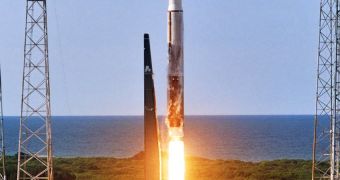NASA's space program is not the only one to carry people and equipment into orbit. There is also the spy-satellite program, which is not so exposed to the media, and not much is disclosed about the secret cargo of some rockets that also take off from the Cape Canaveral Air Force Station in Florida.
As secret as their cargo is, they can't hide a launch from the press, so the news about the unmanned heavy-lift Atlas 5 rocket that blasted off on Thursday is out. The problem is that the payload of the rocket is secret, and details about the rocket's destination and payload were not released.
The only public mentions were made by the industry trade magazine Aviation Week and Space Technology, who reported in April that the Atlas rocket was carrying a pair of ocean surveillance satellites.
The National Reconnaissance Office handled the launch of the Atlas 5 rocket, built by Lockheed Martin Corp. and marketed under a new Lockheed-Boeing Co. joint venture called United Launch Alliance.
On March 16, 1955, the United States Air Force officially ordered the development of an advanced reconnaissance satellite to provide continuous surveillance of "preselected areas of the earth" in order "to determine the status of a potential enemy's war-making capability."
Not much is known about the development of the program after the 70s, but that's why they're called "spy" satellites, so the actual launch of the rockets carrying the satellites is the only time this kind of missions are made public.
A few up-to-date reconnaissance satellite images have been declassified on occasion, or leaked, as in the case of KH-11 photographs which were sent to Jane's Defence Weekly in 1985. The magazine was made infamous when a naval intelligence analyst with the U.S. Navy, Samuel Loring Morison, leaked KH-11 satellite photographs of the under-construction Soviet aircraft carrier Leonid Brezhnev (now Admiral Kuznetsov) at Nikolaiev to JDW.

 14 DAY TRIAL //
14 DAY TRIAL //